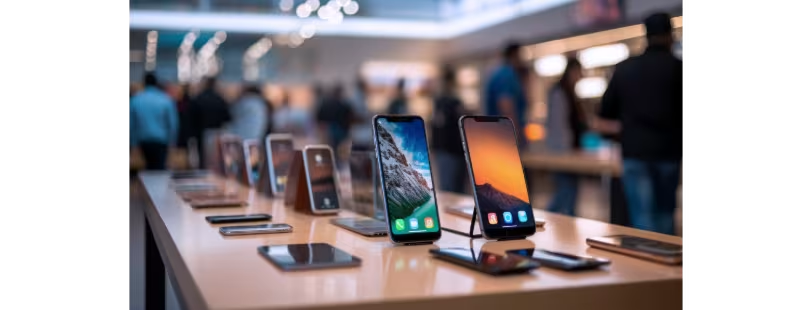
Global Smartphone Market Rebounds in Q3 2025 — AI and Foldables Lead the Charge
After a sluggish start to the year, the global smartphone market made a solid comeback in the third quarter of 2025. According to new data from IDC and Omdia, worldwide shipments rose by roughly 2.6–3 percent year-on-year, reaching around 323 million units. This growth signals a clear rebound in consumer demand, supported by a mix of AI-driven innovation, renewed upgrade cycles, and the booming foldable segment.
The recovery also reflects how major brands have adapted—not just by pushing hardware boundaries, but by rethinking pricing, financing, and accessibility in a challenging economic climate.
Samsung Stays on Top with a Balanced Play Between Innovation and Affordability
Samsung once again secured its crown as the world’s top smartphone vendor, claiming 19 percent of global market share in Q3 2025. The South Korean giant’s success rests on a dual approach: blending premium foldables like the Galaxy Z Fold 7 and Z Flip 7 with its mass-market A-series, which continues to dominate in developing regions.
IDC reported Samsung shipped 61.4 million smartphones, up from 57.7 million a year ago — its strongest July-quarter growth on record. Omdia credited this to a “disciplined but dynamic portfolio” that appeals to both the tech-savvy and price-conscious.
Aggressive trade-in deals, flexible installment programs, and a deep focus on AI integration across the Galaxy ecosystem have given Samsung a clear advantage. The company’s ability to maintain high margins while scaling volume is becoming a benchmark for others in the Android world.
Apple Hits Record Q3 with iPhone 17 Series and Strong Global Demand
Not far behind, Apple delivered its best-ever third quarter, capturing 18 percent of global shipments — a 4 percent year-on-year increase. IDC noted Apple shipped 58.6 million iPhones, up from 57 million last year.
The newly launched iPhone 17 series has performed above expectations, especially the base iPhone 17, which offers upgraded storage and battery life without a price bump. Meanwhile, the iPhone 17 Pro and Pro Max have solidified Apple’s dominance in the premium category, attracting strong demand in Europe, Japan, and North America.
Interestingly, Omdia also highlighted the iPhone Air as a “technical experiment”—a lightweight model that might shape Apple’s next-gen form factors. It’s an example of how the Cupertino brand continues to test new boundaries while keeping its ecosystem tight and profitable.
Xiaomi Regains Strength with Competitive Midrange Lineup
Xiaomi held its position as the world’s third-largest smartphone maker, with 14 percent market share in Q3 2025. Shipments rose slightly to 43.5 million units, driven by its Redmi Note and Poco lines.
Xiaomi’s renewed push in Europe and Latin America is paying off. The company smartly focused on AI-enhanced cameras and competitive midrange devices, catering to post-pandemic consumers looking for high specs at low prices.
Omdia credited Xiaomi’s smooth inventory management earlier in the year for its ability to capture the Q3 rebound — a lesson many rivals missed during volatile market swings.
Transsion and Vivo Expand Their Reach Across Emerging Markets
The two fastest risers this quarter came from outside the traditional top three. Transsion Holdings — parent company of Tecno, Infinix, and Itel — along with Vivo, each secured 9 percent of global market share, according to Omdia.
Transsion’s shipments jumped from 25.7 million to 29.2 million units, marking its best-ever third quarter. Its strength lies in mastering the sub-$200 segment, with strong traction across Africa and South Asia. IDC analysts called Transsion “the quiet engine” behind smartphone adoption in emerging markets — where affordability still dictates growth.
Vivo, meanwhile, shipped 28.8 million units, up from 27 million last year. Its success is tied to AI-powered photography and localized marketing, especially in India, Indonesia, and the Middle East. Aggressive online campaigns and competitive midrange pricing have put Vivo back on the map after a slow 2024.
AI, Foldables, and Financing: The Three Growth Catalysts
Both IDC and Omdia agree that the three main forces shaping today’s smartphone market are AI, foldables, and creative financing models.
“Manufacturers have mastered the art of combining innovation with accessibility,” said Nabila Popal, Senior Research Director at IDC.
“AI isn’t just a buzzword anymore — it’s becoming the core of how users experience their phones.”
Runar Bjorhovde of Omdia echoed that sentiment, noting that the race for AI integration has intensified — but so have profitability pressures. With rising component costs and slimmer margins, brands are under pressure to differentiate beyond hardware — through ecosystem lock-in, AI services, and subscription bundles.
Omdia’s report also observed that design differentiation — from bold colors to rear-display innovations — has become a powerful marketing weapon, especially in crowded Android markets.
Outlook: AI Phones to Drive a Year-End Surge, But Profit Margins Under Strain
Looking ahead to Q4 2025, both research firms forecast a strong holiday quarter as brands push AI-optimized models and discount-heavy promotions. IDC expects total smartphone shipments to finish the year in positive territory, marking the first full-year growth since 2021.
Yet challenges persist. The balance between innovation and profitability remains delicate — especially as BoM costs climb and competition in emerging markets intensifies. Analysts predict that brands with a robust ecosystem — like Samsung’s Galaxy AI, Apple’s integrated services, or Xiaomi’s connected device portfolio — will maintain an edge through ecosystem monetization rather than device-only profits.
Alertify Take: The Smartphone Market Is Evolving, Not Exploding
The Q3 rebound is a healthy sign, but not a full-blown boom. As global inflation pressures ease, consumers are returning to upgrade cycles — yet they’re doing so more strategically, favoring longer-lasting, AI-enhanced, and finance-friendly phones.
The winners in 2025 are those who combine innovation with inclusion. Samsung and Apple continue to dominate the top end, but the rise of Transsion, Vivo, and a resurgent Xiaomi shows how regional brands are capturing millions of new users where growth still exists — in emerging markets and midrange segments.
In short, Q3 2025 proved that the smartphone market isn’t stagnant — it’s simply maturing. The next phase of competition won’t be about who ships the most units, but who builds the smartest ecosystem around AI, services, and user experience.











